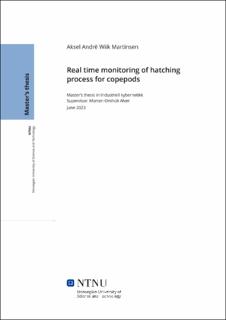| dc.contributor.advisor | Alver, Morten O. | |
| dc.contributor.author | Martinsen, Aksel Andrè Wiik | |
| dc.date.accessioned | 2023-11-01T18:20:04Z | |
| dc.date.available | 2023-11-01T18:20:04Z | |
| dc.date.issued | 2023 | |
| dc.identifier | no.ntnu:inspera:140443607:42529897 | |
| dc.identifier.uri | https://hdl.handle.net/11250/3100119 | |
| dc.description.abstract | Selskapet CFEED produserer copepod-egg av arten Acartia tonsa for bruk som levende fôr i produksjonen av marine arter. En vesentlig del av både produksjon og kvalitetssikring av copepod-egg er å overvåke klekkeprosessen. I dag utføres dette med manuelle telleprøver, som er tidkrevende og fysisk belastende for mennesket som utfører den. Telleprøvene er utsatt for unøyaktigheter grunnet faktorer som tellerens tålmodighet og erfaringsnivå med å skille forskjellige stadier av utviklingen til copepodene. I denne oppgaven vil en sensor bli undersøkt for å overvåke klekkeprosessen ved bruk av maskinsyn og maskinlæring for å måle andelen av egg og klekkede copepoder i nauplii-stadiet.
Et monokromt kamera ble benyttet for bildeinnhenting for å ta høyoppløselige bilder av copepodene. Annotering og forbehandling ble utført for å generere forskjellige datasett. De genererte datasettene ble brukt for å trene et VGG-nettverk og evaluere ytelsen til det trente nettverket. En nøyaktighet på 99\% ble oppnådd på et valideringssett under treningen. Det trente nettverket sliter med å klassifisere bilder fra andre distribusjoner, noe som er nødvendig for å tilfredsstille kravene til en klekkesensor for å overvåke en klekkeprosess.
Arbeidet i denne oppgaven har fremhevet betydningen av kvaliteten til datasettene for den opptrente modellens ytelse, noe som påvirkes av ulike faktorer, inkludert kvaliteten på annotasjonene og variabiliteten i bildene. Det er flere variabler relatert til bildekvaliteten. Design av klekketanken og kameraoppsettet har påvirket resultatene i dette prosjektet. Flere utfordringer ble identifisert og må adresseres i fremtidige studier, som undersøkelser relatert til dybdeskarphet, håndtering av bildestøy, og justering av nettverksstruktur og hyperparametre.
Konklusjonen er at testoppsettet av klekkesensoren klarer å klassifisere med tilfredsstillende treffsikkerhet. Det er behov for ytterligere forbedringer for å lage en funksjonell prototype. | |
| dc.description.abstract | The company CFEED produces copepod eggs of the species Acartia tonsa for use as live feed in the production of marine species. Monitoring the hatching rate is essential to the production and quality assurance of the copepod eggs. Today, this is performed with manual counting tests, which are time-consuming and physically straining for the human observer, but also exposed to inaccuracies due to factors such as observer patience and experience in deciding the distinct stages of Acartia tonsa development. In this thesis, a sensor will be investigated to monitor the hatching process using machine vision and machine learning to classify the proportion of eggs and hatched copepods at the nauplii stage.
A monochrome camera was employed for image acquisition, capturing high-resolution images of the copepods. Annotation and pre-processing of the images were conducted to generate datasets. The generated datasets were used to train VGG networks and evaluate the performance of the trained network. An accuracy of 99\% was obtained on a validation set during training. The trained network struggles to classify images from other distributions, which is necessary for a hatching sensor to monitor a hatching process.
The research has highlighted the importance of dataset quality for the performance of the trained model, which factors including the quality of the annotations and the variability in the images can influence. Several variables related to the quality of the images, hatching tank design, and camera setup have influenced this project's results. Several challenges were identified and need to be addressed in future studies, such as investigations related to depth of field, handling of image noise, network architecture, and hyperparameter tuning.
In conclusion, the test setup of the hatching sensor can classify with satisfactory accuracy. The setup needs further improvement to make a functional prototype. | |
| dc.language | eng | |
| dc.publisher | NTNU | |
| dc.title | Real time monitoring of hatching process for copepods | |
| dc.type | Master thesis | |
